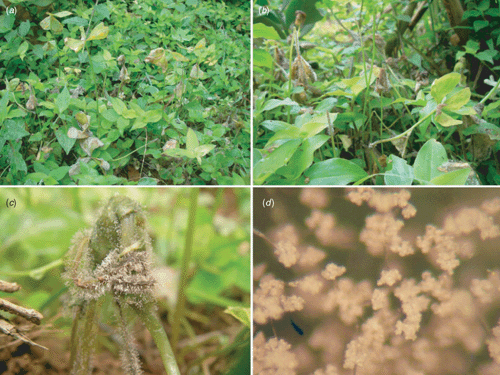Grey mould caused by Botrytis cinerea on Oxalis latifolia from Brazil
D. J. SoaresDepartamento de Fitopatologia, Universidade Federal de Viçosa, Viçosa, MG 36570-000, Brazil. Email: dartjs@yahoo.com.br
Australasian Plant Disease Notes 3(1) 85-86 https://doi.org/10.1071/DN08034
Submitted: 1 June 2008 Accepted: 25 June 2008 Published: 7 July 2008
Abstract
Botrytis cinerea is recorded for the first time causing grey mould on Oxalis latifolia (Oxalidaceae) from Brazil.
Oxalis latifolia, popularly known as broadleaf woodsorrel or Mexican oxalis, is a stemless perennial herb, native to Mexico and parts of Central and South America. It is considered a noxious weed in more than 35 countries and its control is very difficult mainly due to its prolific production of bulbs and bulbils (Holm et al. 1997). According to the former authors, this plant is particularly important in India, New Zealand, Australia, South Africa and Uganda. In Australia, it is considered an important weed in orchards and vegetable crops (Holm et al. 1997). In Brazil, it is considered of secondary importance and is more common in lawns, orchards or coffee crops, although it can be also found in other perennial or annual crops through the south and south-east states (Lorenzi 2000).
In May 2008, plants of O. latifolia were found showing severe disease symptoms, characterised by profuse fungal sporulation covering the leaves and petioles, giving a grey appearance to the tissues, which resulted in the death of the aerial parts of the plants (Fig. 1). When infected tissue was examined under a stereomicroscope, fungal structures characterised by erect to decumbent conidiophores with a powdery spore mass in their apices were observed. Fungal structures were slide-mounted in lactophenol for observation under a compound microscope. Based on the biometric and morphological data, the fungus was identified as Botrytis cinerea (teleomorph: Botryotinia fuckeliana). A sample of diseased material was collected, dried in a plant press and deposited at the herbarium of the Universidade Federal de Viçosa (Herbarium VIC 30608).

|
B. cinerea has been recorded on almost 1000 different hosts worldwide (Farr et al. 2008), and over 60 hosts from Brazil (Embrapa 2008). This fungus was previous recorded on Oxalis spp. from Alaska and Florida (Farr et al. 2008), but no other record on Oxalis spp. was found. This is the first record of this fungus causing grey mould on O. latifolia worldwide.
Acknowledgements
The author thanks the Conselho Nacional de Desenvolvimento Científico e Tecnológico (CNPq) for financial support.


